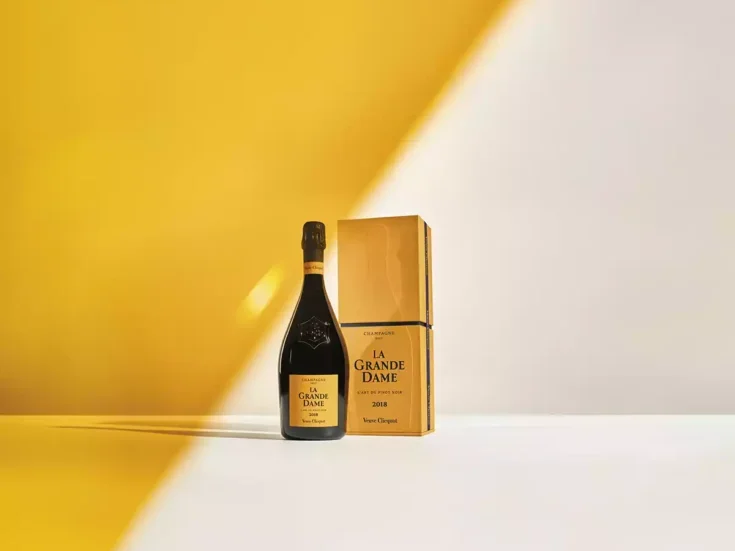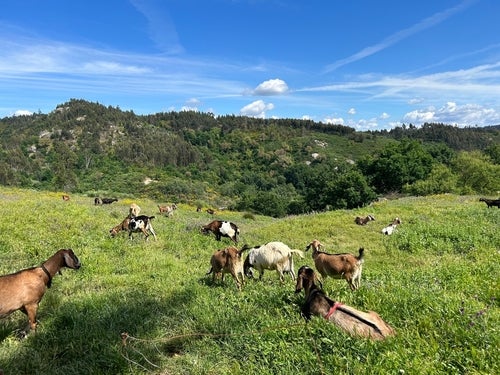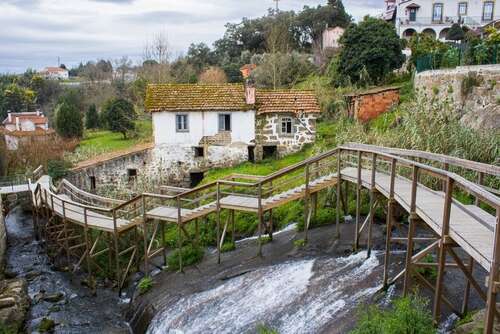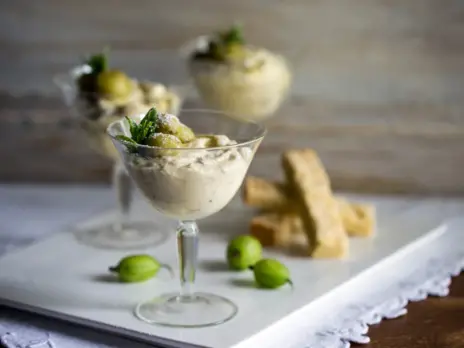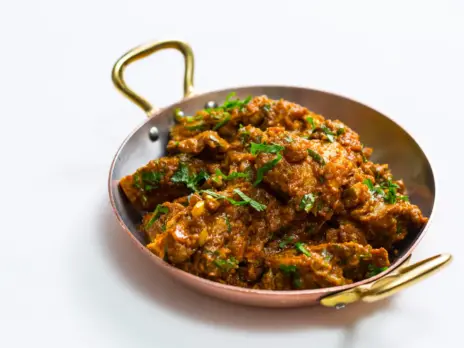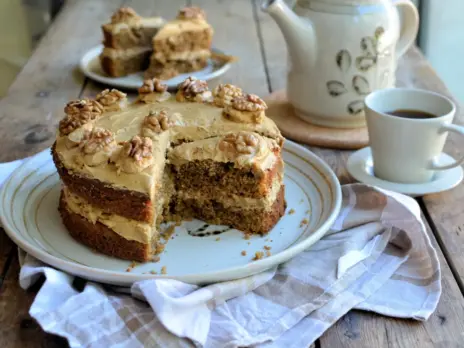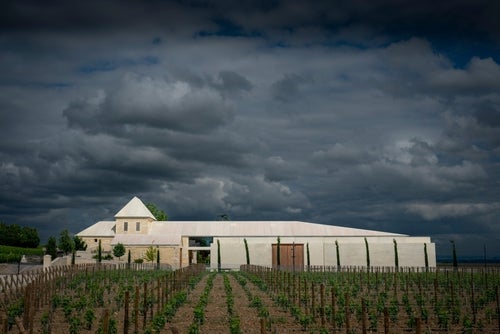
It was on a rare sunny morning early in July 2024 that I inspected the vines on the 7.5ha (18.5-acre) limestone plateau at Château Bélair-Monange, in the company of estate co-owner Edouard Moueix. Copious rain throughout the spring and early summer had led to rapid vine growth and the risk of rot. But wind along this ridge at an altitude of 290ft (88m)—a height surpassing that of neighboring Château Ausone—helped reduce that risk for vines planted as far back as 1934.
Given such downpours, aeration proved essential, Edouard remarked. It was important to trim without necessarily removing leaves. “With global climate change, we have become more certain of ripeness, especially since 2005, so we maintain more canopy,” he explained during my visit, while removing entre-coeurs (the small branches that grow between the vine and the leaves).
The work is more delicate and time-consuming than simple leaf-clearing, but Moueix deems it necessary, the better to withstand the generally higher temperatures and stronger sunlight leading up to harvest. In 2024, he also removed burgeoning grape bunches to improve aeration, preventing rot from spreading to Merlot grapes that would otherwise have been touching.
The estate maintains uncultivated land and hedges around and within vine parcels to encourage the growth of fauna essential to the vineyard’s natural balance. Cover crops adapted to the specific organic composition of each parcel help secure the minerals required for soil health, and the estate adapts plowing and vineyard work to each micro-parcel, based on the season, the water supply, and the age and strength of the vines.
Such care for an exceptional terroir exemplifies the painstaking viticulture and winemaking at this St-Emilion premier grand cru classé ever since Edouard and father Christian Moueix acquired it for Ets Jean-Pierre Moueix in 2008. It also reflects what has become known as the “Moueix touch” in wine.
The Lafite of St-Emilion
After the acquisition, they wasted no time in taking steps to improve the wine and revamp its image. Under prior ownership, the wine had been of good quality but often lacked the brightness and depth expected of a premier grand cru classé.
The Moueix family decided to modify the name of the estate, so that wines produced after the 2007 harvest bear the name Château Bélair-Monange rather than Château Bélair. One reason was an homage to Anne-Adèle Monange, mother of Jean-Pierre Moueix. Another reason, Christian told me over lunch shortly after the acquisition, was to distinguish the estate from the many other Bélair-named Bordeaux châteaux.
In the vineyard, there was a need to replant vines that had become too old and to plant massal selections more carefully from original parcels. But first they needed to strengthen the base underneath the plateau, riddled by underground quarries. Over preceding centuries, builders extracted too much stone from the quarries, to construct local dwellings, seriously weakening the base. After Edouard Moueix and his wife Kelley moved into the château with their children, they were shocked to discover one day an enormous chunk of limestone that had fallen in front of the entrance to the base underneath the plateau, where the wines had been fermented. “It was getting dangerous,” he said. Only after a four-year process to strengthen the base could they begin to replant.
Another important change happened toward the end of those four years: the merger with Château Magdelaine, which had long been a St-Emilion premier grand cru classé itself. Jean-Pierre Moueix acquired Château Magdelaine in 1952, embarking on important renovations to improve the wine, even if the estate had enjoyed an excellent reputation as a top property, at least in the previous century. Many observers felt dismay over the merger, lamenting that St-Emilion had lost a coveted wine. But the merger proved to be a vital part of a plan to return Château Bélair-Monange to an era when Château Bélair enjoyed a distinctive reputation in St-Emilion—as described, for example, in the 1867 book Les Grands Crus Bordelais, “Château-Belair is the Château-Lafitte of St-Emilion. No one disputes its superiority and, as mentioned above, it must be included among the great dignitaries of Bordeaux.”
In 1850, Charles Cocks, in the first edition of the Cocks & Féret guide Bordeaux et Ses Vins, ranked Château Bélair first among all the St-Emilion premiers crus, a ranking that it maintained until 1898. Even before the 19th century, the estate proved a trailblazer in Bordeaux, let alone St-Emilion. Not only did Bélair age its bottles at the château in the 18th century, but from as early as 1802 it also bottled the wines there—both practices that were rare at that time.
Fast-forward to the 21st century, and the estate has clearly benefited from the addition of Château Magdelaine vines, as proved in the tasting for this article. The better to understand the vineyard, Edouard Moueix showed me the horseshoe-shaped 11ha (27 acres) of vines of what was Château Magdelaine. With 6ha (15 acres) also on the famous St-Emilion limestone ridge, close to Château Ausone, and the remainder on clay- and limestone-based slopes facing the Dordogne River, the combination has led not only to more wine but also—far more important—to greater complexity; the merger permits more rigorous selection and more blending options, Edouard explained.
Ode to limestone
This merger, which was ratified by the 2012 classification, and the recognition of Bélair-Monange as a premier grand cru classé prompted yet another step toward improving the wines: a colossal cellar renovation.
The existing vat room and cellar were unsuitable for the enlarged area of 20ha (50 acres) under vine—and as many as 26ha (64 acres) could eventually be in production. (The total surface area is 30ha [74 acres].) The renovation included the addition of 24 concrete vats ranging in size from 48hl to 116hl, the better to ferment the parcel-by-parcel harvest selections, with the vat room adjoining a large space dedicated to receiving the harvest and bottling on-site.
“It is far better to ferment the wines in a more stable environment, which is now less humid and moldy than it once was,” explained technical director Eric Murisasco, who has worked with the estate and the Moueix family for years.
After meticulous sorting and destemming, grapes are vinified in small lots to preserve the characteristics of each parcel. The fermentation takes place in thermo-regulated vats, and—as at other Moueix properties—vinification is gentle, with relatively short macerations, never overextracting tannin. Exposure of the wine to oxygen during its élevage is limited to the strict minimum to prevent premature aging, while the length of the barrel-maturation—generally 14 to 16 months—is adapted to the characteristics of the vintage, to maintain subtle tannins. Barrels used for aging are only about 50% new, to preserve freshness, and the wine is bottled in the spring of the second year following its harvest.
The new cellar space—first used for the 2022 vintage—has improved winemaking precision. Excavations began in 2019, with the inauguration in June 2023. Like the wine, the new cellar communicates not only practical improvement but also a sense of elegant aesthetics. The corridor’s concrete walls reproduce the Albrecht Dürer engraving (1504) that inspired the Bélair-Monange label, remarkably reproduced in wood in the tasting room, where any visitor can sense elegance and refinement overlooking the first-year aging cellar.
“We began the first studies at the end of 2015 with two architects based in Basel—Jacques Herzog and Pierre de Meuron—famous for having designed large sports venues, including the Olympic Stadium in Beijing,” explained Christian at the inauguration ceremony. The architects had already worked with the Moueix family, having built the Dominus Estate winery in Napa (1997) and the Harvesters’ Refectory at Château La Fleur-Pétrus in Pomerol (2002).
The challenge to integrate the new installations within the wine landscape, classified by UNESCO as a World Heritage site in 1999, was more than met. Constructed over the limestone plateau, the building evinces a seamlessness of white stone over the natural landscape, echoing the underlying limestone, thus fitting the subtext of the construction as an “ode to limestone.”
Given the excellence of the terroir, about 80% of the harvest makes it into the grand vin. Following the restructuring of the property, the Moueix family added a second wine starting with the 2014 vintage—Annonce de Bélair-Monange—crafted mainly from younger vines and those that have a more approachable style in any given vintage. The estate also makes a limited production of a third wine, Haut Roc Blanquant (St-Emilion Grand Cru), bearing the name of a historic parcel of the vineyard. Haut Roc Blanquant offers a vibrant, fruit-driven expression of the terroir to enjoy after only a few years in bottle.
The future also looks bright. As new plantings age, the wine will gain in complexity. And the cellars will get busier still with the incorporation into Bélair-Monange since 2022 of the 2.3ha (5.7 acres) of the neighboring Clos La Madeleine. Located on the south-facing plateau and terraces of St-Emilion, Clos La Madeleine is literally nestled in the vineyard of Château Bélair-Monange, planted on the limestone bedrock, and covered, in some areas, by a mere 20in (50cm) of clay. The Moueix family acquired the estate in late 2017, and although its vines have not yet been used for Château Bélair-Monange, they should soon offer more selection choice for the grand vin.
Such demanding work has earned plaudits from the wine industry. Take, for example, German merchant Michael Severin Grimm (at Bacchus Wines), who recalls his first visit to the estate in the mid-1990s, when then director Pascal Delbec welcomed them and they tasted the 1994 vintage. “Elegance and a certain delicacy had always been inherent in Bélair wines, but they lacked structure, balance, and density, as well as needing complexity. Since the incorporation of Château Magdelaine, especially from the 2014 vintage, it became clear in which direction Bélair-Monange would develop—and the last two vintages, 2022 and 2023, are certainly among the best from this château.”
Shaun Bishop of JJ Buckley in California also expresses enthusiasm. “I am a huge fan of Bélair-Monange and what Edouard and Kelley Moueix are doing there,” he said. “Not only is the estate magnificent, but the wines continue to go from strength to strength. With each vintage, the wines are more integrated, focused, and refined.”
Bordeaux enologist and author Nicolas Vivas, whom I met over dinner at Château Bélair back in 2003 with Pascal Delbeck, remarked, “I am impressed by the hard—and expensive—work that the Moueix family has undertaken to express the unique terroir of Bélair.”
Tasting all 15 vintages since the arrival of Christian and Edouard Moueix indeed reflects a clear progression in quality. Some earlier vintages lack the impact of other great St-Emilion peers (though the 2009 is stunning); nor do they quite match the quality of upper-echelon Pomerol properties also belonging to Ets Jean-Pierre Moueix, such as Château La Fleur-Pétrus, Hosanna, and Trotanoy, but the more recent vintages are clearly top-notch, conveying aromatic and textural finesse, palate depth, and the éclat inherent only in great wines. In addition to the benefit of the merger with what was Château Magdelaine, another factor is that the 2015 vintage was the first to include fruit from replanted vines on the plateau, given the four-year lag to reinforce the base underneath. So, starting with the 2015 vintage, the wine reflects an increasing number of plateau-harvested grapes. Common elements when tasting Château Bélair-Monange include finesse expressed in wet stone—or “minerality”—freshness, often floral, and a long finish. Finally, the wine conveys a sense of class, derived from keen attention to the details and practical steps that make Château Bélair-Monange as exciting as it can be.
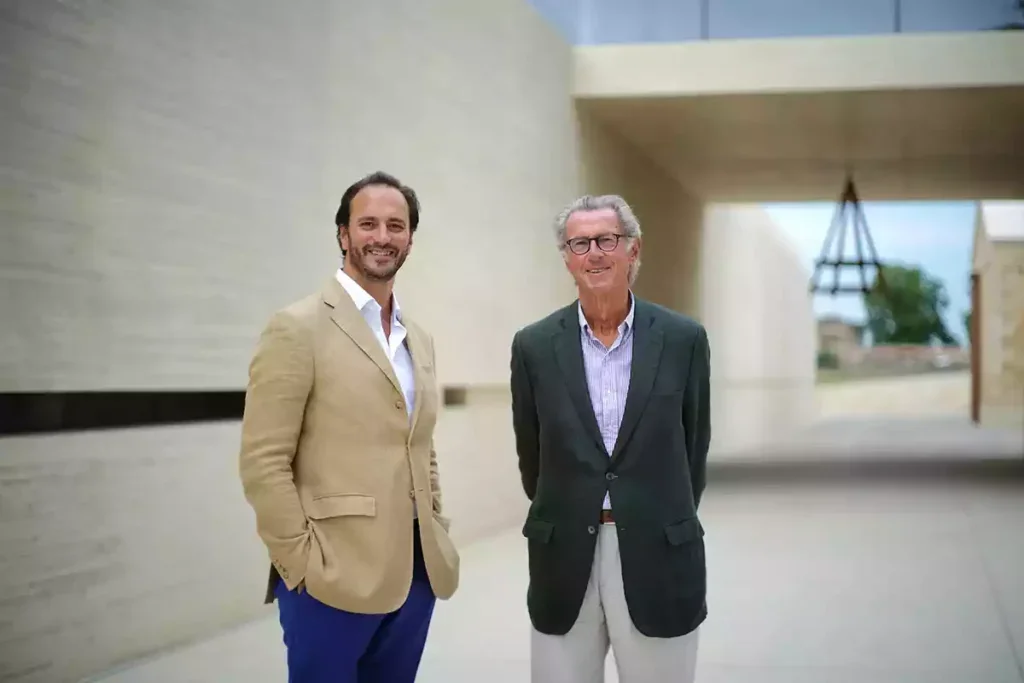
Soil categories
Reaching an altitude of 290ft (88m), the plateau of Bélair-Monange is located on the southern edge of the medieval town, overlooking the historic heart of the premiers grands crus classés of 1955. It boasts exceptional asteriated limestone terroir covered by a thin layer of clay, with a specific mesoclimate that gives the wines rare elegance and complexity.
The terraces of Bélair-Monange overlook the Dordogne Valley to the south. These parcels, planted according to the plot’s incline, enjoy ideal solar exposure throughout the growing season and are well suited to producing deep, rich wines. The soil is composed of blue clay over asteriated limestone, a combination that leads to intensity, length, and elegance.
The south-facing slopes (known as côtes) of Bélair-Monange are an extension of the terraces and boast the same privileged sun exposure and exceptional drainage. The soil—silty clay over deep clay—favors the production of rich, round, generous wines.
Timeline
6th century ce: In St-Emilion, vines are planted alongside other food crops, as suggested by the remains of a sumptuous villa at the foot of Bélair-Monange’s hillside parcels.
1688–1916: This is an important era for Bélair-Monange, when it was owned by a single family, the Canolle de Lescours, for almost 230 years. The noble house of Canolle, located in St-Emilion since the 16th century, descended from Robert Knowle (1312–1407), lieutenant of the King of England and Seneschal of Guyenne. The Bélair estate grows to 13ha (32 acres), the size of the vineyard until the early 21st century.
1750s: The current château is built.
1916: Edouard Dubois and his wife Marie Challon acquire Château Bélair.
1937: Jean-Pierre Moueix, the youngest son of Jean and Adèle Moueix, founds the wine-merchant business Etablissements Jean-Pierre Moueix on the Quai du Priourat in Libourne.
1955: Château Bélair is named premier grand cru classé during the first official classification of St-Emilion wines (revised every 10 years).
1960: Jean-Pierre Moueix, owner since 1952 of Château Magdelaine, an adjacent premier grand cru classé, becomes exclusive distributor of Château Bélair.
1974: Château Bélair’s owner Jean Dubois-Challon dies. His widow, Helyette, inherits the property.
2003: Helyette Dubois-Challon and Jean-Pierre Moueix die. Pascal Delbeck (manager since 1976) inherits Château Bélair.
2008: Christian and Edouard Moueix, son and grandson of Jean-Pierre Moueix, acquire Château Bélair and rename the estate Bélair-Monange in memory of Adèle Moueix (née Monange).
2012: During the 10-year classification of St-Emilion wines, Bélair-Monange and Magdelaine are confirmed as premiers grands crus classés. INAO agrees to their fusion into a single 23.5ha (58-acre) property.
2022: The Clos La Madeleine vineyard is integrated into Château Bélair-Monange.
2023: Although already used for the 2022 vintage, the estate’s new cellar—designed by award-winning architects Herzog & de Meuron—is officially inaugurated.
Tasting
2008 Château Bélair-Monange St-Emilion Premier Grand Cru Classé
(83% Merlot, 17% Cabernet Franc; 14% ABV; pH 3.61; 30% new oak for 14 months)
The first vintage under the direction of the Moueix family. Harvested late, October 13–21, it reflects the vintage’s naturally high acidity, with ripeness gained after a rather late harvest. The attack has a firm, almost metallic edge (not sharp). Noticeably powerful tannin comes to the fore, accentuated by an acidity that lends vivacity. The wine reflects lovely aromas and flavors of red plum, blackberry, licorice, and even rhubarb. While the mid-palate creaminess is almost Pomerol in style, the wine displays a slight rawness to the tannin toward the end of the finish, which is of moderate length. 2025–40. | 94
2009 Château Bélair-Monange St-Emilion Premier Grand Cru Classé
(85% Merlot, 15% Cabernet Franc; 14% ABV; pH 3.55; 30% new oak for 14 months)
This vintage exudes remarkably gorgeous aromas of ripe plum, peony, and violet, akin to an alluring perfume. An earlier harvest than in 2008 and a more successful balance, being far more polished than the 2008—more spherical—without any modern gloss. The refined tannins reflect none of the rawness of the preceding vintage, and even if some vintage warmth is detected, the 2009 vintage has a lower pH and comes across as very balanced, leading to a long finish that echoes the superlative aromatic quality of this wine. 2025–50. | 98
2010 Château Bélair-Monange St-Emilion Premier Grand Cru Classé
(85% Merlot, 15% Cabernet Franc; 14.5% ABV; pH 3.54; 30% new oak for 15 months)
After trying two bottles—the first had a cork problem—I remain a bit quizzical about this storied vintage, at least here. Yes, the 2010 is more about power than the 2009, and it should outlast it, given the backbone. You get more alcohol—14.5% rather than 14%—and a bit more acidity, too. And there is charm in the form of chocolate-brownie sumptuousness on the mid-palate. But something seems slightly out of balance by comparison with the more elegant 2009. There is higher alcohol here, but also a hint of rusticity to the tannins, which recalls the 2008. Long finish. Give it more time in the cellar while you enjoy the 2009. 2025–55. | 95
2011 Château Bélair-Monange St-Emilion Premier Grand Cru Classé
(90% Merlot, 10% Cabernet Franc; 14% ABV; pH 3.45; 30% new oak for 14 months)
One of the top wines from this tasting, which convinces me that 2011 can be underrated from certain producers—and the Moueix family were by now acquiring a better understanding of the property. July was “capricious,” but sunny and warm weather thereafter led to a healthy, earlier harvest: September 14–24. I like the autumnal freshness—reflected in the low pH of the wine—with subtle notes of fine chocolate, tea, and forest leaf, but not desiccated or old; rather, fresh and balanced by mid-palate creaminess. The long finish is marked by a note of damson and a hint of plum eau de vie. More pleasurable than the 2010. Call me crazy. 2025–50. | 96
2012 Château Bélair-Monange St-Emilion Premier Grand Cru Classé
(90% Merlot, 10% Cabernet Franc; 14.5% ABV; pH 3.58; 30% new oak for 14 months)
This vintage is reputed to be round and friendly, but it is not as long as the 2011. The wine opens with a lovely attack marked by a delectable, jammy nose of ripe fruit, juicy blackberry, and crisp red cherry, along with licorice aromas and flavors. Harmonious oak-derived notes complement the juicy mid-palate, but—as one could expect—the finish is more abrupt than the pleasing attack and mid-palate suggested. Given the inherent quality (palate finesse and ripeness of tannin), you could drink it with enjoyment from 2025, but the wine should develop more tertiary complexity over the next 10–15 years. 2025–50. | 94
2013 Château Bélair-Monange St-Emilion Premier Grand Cru Classé
(90% Merlot, 10% Cabernet Franc; 14% ABV; pH 3.59; 35% new oak for 14 months)
Only 14,706 bottles were made in this challenging vintage (compared to nearly 19,000 in 2012), but the nose is charming, with rose-stem and grassy meadow aspects. While the palate lacks density and comes across as a veritable luncheon claret, the good news is that judicious extraction led to the best-possible tannin—otherwise, this fragile wine would have been overwhelmed. Thus, no hard edges even if the wine is hardly remarkable. Drink up. 2025–30. | 90
2014 Château Bélair-Monange St-Emilion Premier Grand Cru Classé
(88% Merlot, 12% Cabernet Franc; 14.5% ABV; pH 3.57; 45% new oak for 14 months)
The first vintage incorporating what had been Château Magdelaine—which explains the nearly 32,000 bottles produced—resembles the pleasing, autumnal style of the 2008 vintage, albeit harvested earlier than that vintage, between September 27 and October 8. But the 2014 vintage is more vibrant, with more vivid, crackling, autumnal berry fruit. The nougat-like mid-palate richness reflects ripe Merlot that makes up 88% of the blend, while the remaining Cabernet Franc lends noticeable minty freshness. While the tannins lack the supreme splendor of the 2009 vintage, they “make sense,” and this wine will age gracefully in your cellar, because it has more warmth and sumptuousness than many of its peers in 2014. 2025–55. | 95
2015 Château Bélair-Monange St-Emilion Premier Grand Cru Classé
(88% Merlot, 12% Cabernet Franc; 15% ABV; pH 3.59; 50% new oak for 15 months)
I feel conflicted about this vintage, the first to incorporate a significant number of plateau-harvested grapes after four years to reinforce the base underneath (see main text). It has the highest alcohol so far, at 15%, reflecting the ultra-ripe fruit, and there is some alcohol warmth: comparatively burly after the 2014, for example. It is, however, pleasing, and when I tasted it more recently—in January 2025 in London at the 2015 “Ten Years On” horizontal hosted by Bordeaux Index—the wine was more precise than many of its Right Bank peers, with orange-rind freshness on the finish. I do, however, miss the more spherical aspect of the 2009 and the more remarkable precision of the 2016. 2025–55. | 94
2016 Château Bélair-Monange St-Emilion Premier Grand Cru Classé
(92% Merlot, 8% Cabernet Franc; 14.5 ABV; pH 3.6; 50% new oak for 15 months)
Cooler than the 2015 and better, exhibiting blue fruit along with ripe blackberry and plum. Time in the glass recalls a Médoc style, with a sense of graphite, of lead pencil, and a certain coiled-in aspect, packing subtle power and exciting tension and balance. The long finish exudes tobacco-leaf freshness. This is a superb wine that will only gain in complexity over decades in your cellar! 2025–63. | 98
2017 Château Bélair-Monange St-Emilion Premier Grand Cru Classé
(98% Merlot, 2% Cabernet Franc; 14.5% ABV; pH 3.5; 50% new oak for 15 months)
The whopping 98% Merlot in the blend reflects almost sweet fruit and comes across as appealing aromatically. But then the palate dissipates; it seems rather loose knit, the aromatic promise not quite realized. A wine to enjoy today with grilled steak, even if tertiary complexity would require more time in the cellar. While the 2017 vintage lacks the power and tension to achieve the same complexity as the 2016 or the 2014, its palate depth reflects a veritable premier grand cru classé from a decent vintage. 2025–50. | 94
2018 Château Bélair-Monange St-Emilion Premier Grand Cru Classé
(98% Merlot, 2% Cabernet Franc; 15% ABV; pH 3.58; 50% new oak for 15 months)
High yields resulted in a whopping 42,960 bottles (the highest so far in this series), which means both quality and quantity in 2018. Here the 15% ABV is far better managed than in the 2015 vintage. Quite floral and eau de vie cherry and plum aromas presage a palate with cohesion, balance, and better grip than in 2015, which has a similar vintage profile on a general level. While this is no cool 2016 style, which I ultimately prefer, the 2018 has such nuanced palate texture and suave richness that you cannot help but take further sips! Quite an impressive wine, combining tannic finesse and balance with the high alcohol. A long finish, too. This could be enjoyed with fine cuisine or even on its own, as a high-end by-the-glass selection. 2025–65. | 97
2019 Château Bélair-Monange St-Emilion Premier Grand Cru Classé
(96% Merlot, 4% Cabernet Franc; 15% ABV; pH 3.57; 50% new oak for 15 months)
This vintage combines the advantages of 2016 and 2018, resulting in a stupendous wine: bright plum and juicy blackberry aromas introduce a gorgeously textured palate where the 15% ABV is even better balanced than in the 2018 by the slightly higher acidity. And the wine displays the most impressively smooth tannins so far in the Moueix era, leading to a long, clean, and lifting finish. Since this was a vertical, I compared it again to the 2018 vintage, and the 2019 has superior floral lift and energy. Furthermore, it reveals a sense of pure limestone, even more than the 2016 does. Very long finish. The 2019 vintage marks a significant turning point at this estate. 2025–70. | 99
2020 Château Bélair-Monange St-Emilion Premier Grand Cru Classé
(98% Merlot, 2% Cabernet Franc; 14.5% ABV; pH 3.62; 50% new oak for 14 months)
Tasted at the estate, I have caught the 2020 in a closed-in stage. Compared to the 2019, it has a more toned-down nose, albeit evoking limestone salinity, fine chocolate (brownie), and damson fruit. Even if rather closed, time in the glass reveals a palate of—for now—“contained opulence,” as if the wine included a dollop of Vintage Port delivered in velvety tannins. But it all comes across in a lower key than the far more expressive 2018 and 2019 vintages. For now, a conservative score, but time in the cellar should raise it. 2028–70. | 97
2021 Château Bélair-Monange St-Emilion Premier Grand Cru Classé
(99% Merlot, 1% Cabernet Franc; 14% ABV; pH 3.6; 40% new oak for 14 months)
After a trio of excellent vintages, the 2021 underwhelms, but the estate still did an excellent job in a difficult year. A bright attack leads to a medium-bodied palate of ripe red rather than black fruit, including raspberry and cherry. The somewhat chalky tannins reflect youthful tightness (it is, after all, still only a baby). The finish is a bit short, unlike the three prior vintages, but this vintage would be a good choice to enjoy between 2027 and 2040. 2028–55. | 94
2022 Château Bélair-Monange St-Emilion Premier Grand Cru Classé
(100% Merlot; 14.5% ABV; pH 3.77; 50% new oak for 15 months)
A magnificent vintage that evokes an expensive, well-cut suit: Everything is in place and looks great. While the pH is higher than usual, the alcohol clocks in at 14.5%. More important than such figures is the amazing display of wet-stone freshness combined with Médoc-style lead pencil and crushed tobacco—even if this vintage is 100% Merlot. The full-bodied palate is expressed with gorgeous tannic finesse. Excellent balance and a very long finish. 2028–70. | 98

